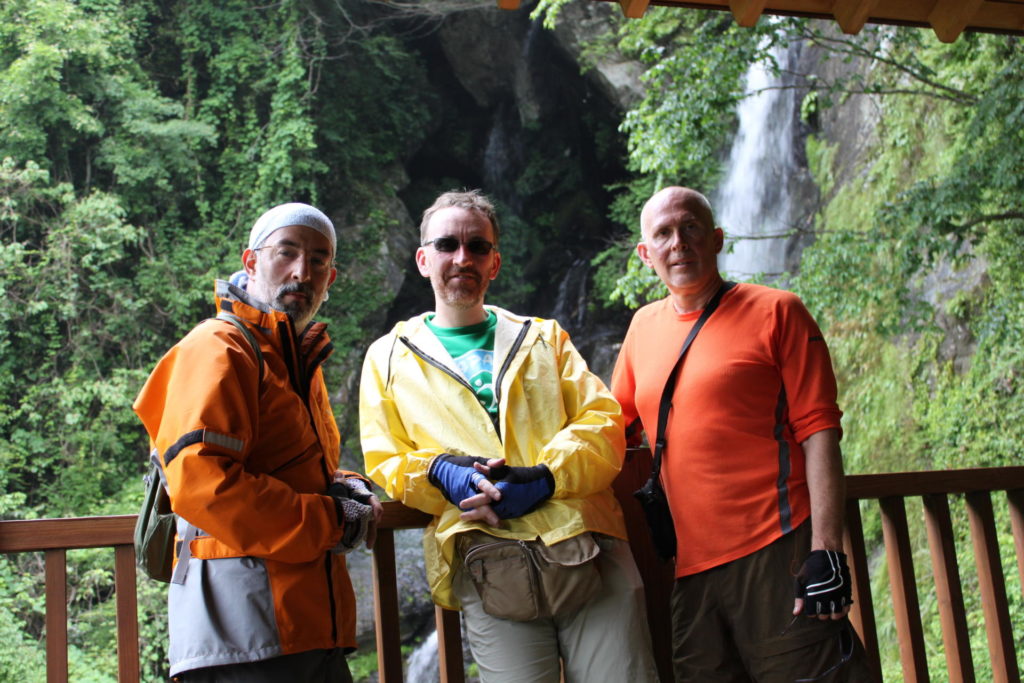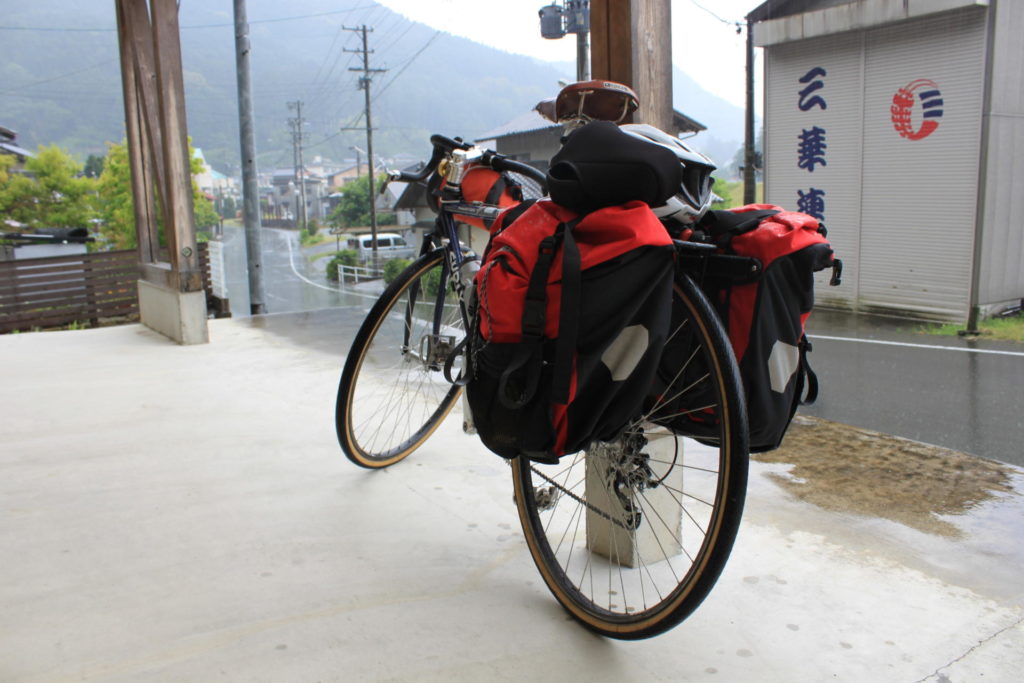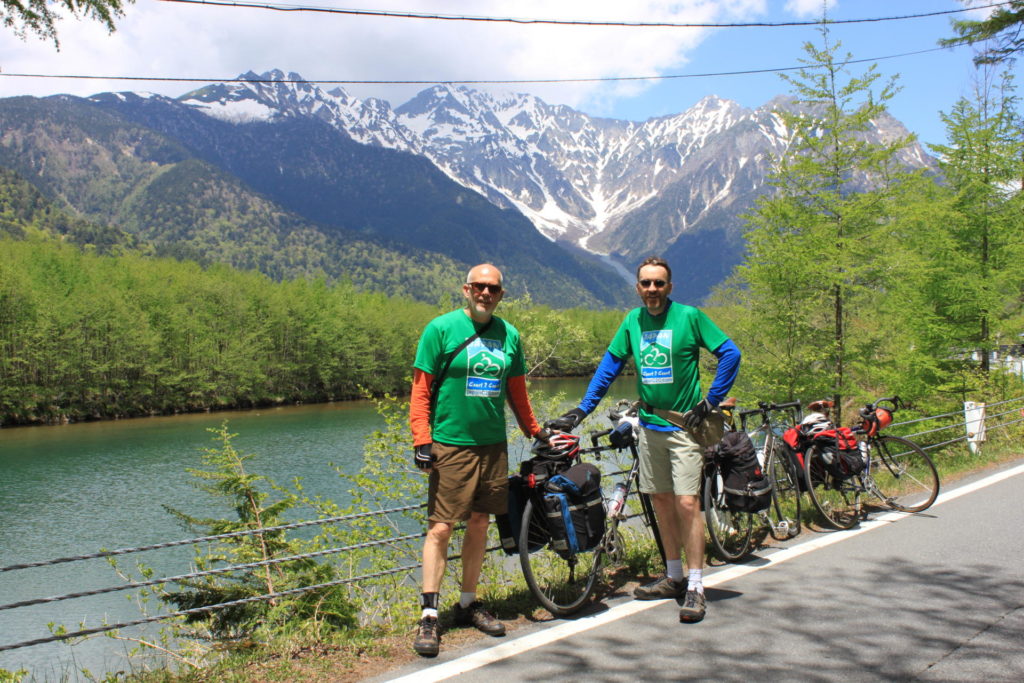The idea for Japan Coast to Coast, following famous rivers and crossing some of Japan`s highest roads, came 10 years ago when I had an accidental meeting with an Englishman. His name was Walter Weston and, in fact, he had been dead for more than 60 years.

I met Walter Weston on a forgotten road suspended on the granite cliffs where the Japan Alps spill into the sea. The chance meeting changed my outlook. I was halfway through a 3,000-kilometer bicycle journey from Kyushu to Hokkaido, following the elusive cherry blossoms, hugging the Japan Sea coast, to avoid the steep grades of inland Japan.
The day was spectacular: the sun warm, the sky blue and the variegated blue and green hues of the sea were rendered all the richer by the dynamic phosphorescent spray, a slat-like whiteness scattered across the body of water separating Japan from Korea.
In order to avoid riding my bike through a dangerous tunnel, I veered off on the old road. It meant adding several hundred meters to what would already have been a 125K day, but it was worth it. One thing I hated more than mountain passes was tunnels. Besides, the views over the Japan Sea were worthy of a long, quiet look. The place was Oyashirazu, and the road I was on, it turned out, was an ancient one connecting north Japan with west Japan by traversing cliffs along the Japan Sea.
Weston came to Japan in the late 1800s and, despite having heard his name, I didn’t know much about the man. But here on this forgotten road there was a full-size bronze statue celebrating his life. In addition to the obscure location of the Weston monument, there was something about his deportment that gave me a gentle rebuke.
Weston’s back was to the sea, his head tilted, his steely gaze clearly on the mountains looming overhead. The script engraved in brass at the foot of the statue explained that Weston was the “father of mountaineering in Japan” and had begun one of many summer expeditions at this point because it was here where the North Alps literally rise out of the sea.
I determined then I would one day ride the direction Weston was looking…up and over the mountains. It took 10 years, but my dream finally came true. The sudden death of my father and a six-week illness at the beginning of the year prompted me to ride the Weston Trail in June this year. Two friends, Tony Torres and Mark McBennett, joined the trip, and together we began to plan the route and prepare for the journey.
Tony dubbed us the “three amigos.” He had been riding a few years and had completed part of the Tour De France route. His preparation involved doing hot yoga several times a week and a one-day, 170-K ride from Nagoya to Kyoto on his fold-up Surly. Mark started from scratch, dusting off his old mountain bike in February, eventually buying a Giant Defy in early May.
He was tentative but hopeful and committed a few weeks later. For me, it was about steadily building up my strength and cardio capacity. My illness had left me eight kilograms lighter, which was a dividend. The rides were usually short, less than an hour, but always included at least one ascent of Mt. Jokoji behind my house.
We set off the first week of June, timing our arrival in Kamikochi to coincide with the annual Walter Weston Festival which marks the opening of the alpine season in Japan. Two weeks earlier, we had made a recon trip to Hamamatsu, to locate the mouth of the Tenryu River (Tenrugawa) and plan our trip through the remote Southern Alps. After, we had little doubt the ascents would be grueling and often.
The day of our departure, we assembled our bikes in Hamamatsu and rode to the mouth of the Tenryu and took ceremonial photos dipping our back wheels in the sea where the river pours into the Pacific Ocean.
The first 20K was pleasant, following a flat, straight road and with little traffic along the river. Eventually it gave way to hills with all of the curves and undulations that make cycling so pleasant in Japan. We passed our last convenience store for 150 kilometers as we continued to follow the river on smaller ancillary roads when available.
The first day ended with a nine-kilometer climb, at times on a 14% grade, to our mountain-top pension. The owner of the pension, concerned we might not find our way, appeared halfway, pointing out all the special sites along the way, including waterfalls and places where fireflies gather. Five-hundred meters from Furosato Pension, a deer dashed across the road just in front of us. An hour later, we were enjoying a meal that included venison.
The pension owner told us about a short cut down the backside of the mountain, which would knock several kilometers off our trip down to Sakuma Dam. “There is a couple hundred meters of rough road where you may need to walk,” the owner said. In fact, two of the 10 kilometers were very rough, resulting in a broken spoke for Mark. He continued to ride nearly 150K minus the spoke before getting it repaired in Ina the following day.
The third day was a delightful ride up the valley to Ina, and on to the dreaded Gonbi Tunnel. As we ascended, the mountain gods seemed to be angry as the rumbling of thunder roaring down from the Central Alps was getting louder and louder. Although we got through the tunnel without incident, we were greeted by pelting rain on the other side which accompanied us down the valley where we would spend the night.
Day four was full of surprises. It included two mountain passes, an unexpected interview by a NHK film crew (they were filming a Coast to Coast ride of two celebrity riders coming from the opposite direction), meeting a young couple living off the land and negotiating a road that was closed due to a landslide. We eventually arrived to a warm welcome at Northstar Adventure Lodge.
Kamikochi was a highlight for us all, even though the final tunnel into the valley was daunting. There we met up with some friends from Nagoya and met a fellow cyclist who was riding up the spine of Japan. We rented a small cabin, and Tony prepared a great pasta meal we enjoyed with a bottle of red wine.
Kamikochi was made famous be Walter Weston, who likened it to Zermatt, and the next morning we witnessed the 64th Annual Walter Weston Festival which included school children singing the Walter Weston theme song. The celebration marks the opening of mountain climbing season in Japan.
Our penultimate day was a delightful descent into Matsumoto and then the wonderfully pleasant Salad Road nearly all the way to Hakuba. The road is undulated with a few gentle curves, through orchards, gardens and by numerous galleries and bistros. Albert Kikstra of the Santana B&B gave us a warm welcome and we enjoyed his family’s hospitality.
We ended our journey where I first envisaged it 10 years earlier, at the Walter Weston monument. Over the course of the week, we rode just over 500K in eight days, gaining eight kilometers in elevation. When possible we chose remote, abandoned and sometimes closed roads. Tunnels were our nemesis. We rode far too many of them, including the five-kilometer Gonbi Tunnel that aided our crossing of the Central Alps, and a stretch of nearly 17 kilometers of non-stop tunnels and snow sheds on the final day from Hakuba to Itoigawa.
Every day was an adventure, reconfirming the view that Japan is a great place for long-distance cycling. Not only was it a great ride, but alsowith the support of friends and family, we raised more than ¥600,000 for HOPE International Development Agency, enough to provide fresh water wells for about 30 families.
Plans are now underway for a two-day version of the Japan Coast to Coast, Oct. 10-11, where we hope to have about 20 cyclists join in the fun. In 2011, we are planning a team event repeating the route we did this year, although we plan to cut a day or two off the itinerary. Both events will have a charity aspect with HOPE International Development Agency. More information is available at www.japanc2c.com.

Japan Coast to Coast
About Japan C2C
The idea behind Japan Coast 2 Coast was a simple one: To explore two great rivers and three great mountain ranges in Japan by bicycle while raising money for people in desperate need of clean water. We cycled some of Japan’s highest highways following the trail of Walter Weston, widely considered the father of mountaineering in Japan.
We started at the mouth of the Tenryu River, on the Pacific Ocean side of Japan, cycled alongside the Southern Alps, crossed over the Central Alps, the summit of Norikura and took in the annual Walter Weston Festival in Kamikochi before cycling to the Japan Seacoast following the Hime River (Himekawa) through Hakuba to Itoigawa.
Our main aim was to explore remote regions of Japan by bike. But we also leveraged our adventure to give families living in remote reaches of Cambodia a chance to become self-reliant.
Japan Coast to Coast

Total Distance: 508 kilometers
Day 1: Hamamatsu Station –> Mouth of the Tenryugawa –> Tatsuyama [70K]
Meet at the mouth of the Tenryu River. Follow the river course upstream. No mountain passes this day, however the last nine kilometers was a killer climb, at times 15 %.
Day 2: Tatsuyama –> Yasuko [77K]
Descended a forest trail so we could climb again up the Sakuma Gorge to the dam and follow a meandering mountain road for most of the rest of the day to Yasuko, south of Iida.
Day 3: Yasuko –> Yasubara [103K]
Continued to follow the Tenryugawa to Ina where we had lunch and fixed a broken spoke on Mark’s bike. We enjoyed the South Alps on our right and the Central Alps on our left. We ascended the Gonbi Highway to the five-kilometer tunnel that burrows its way through the Central Alps. A fast descent on the other side to the wretched Route 19, where we suffered for four kilometers in the rain before reaching our minshuku.
Day 4: Yasuko –> Norikura Kogen [45K]
After a short descent into town, we began the first of two ascents. Nagawa Onsen was tucked between the two.
Day 5: Norikura –> Kamikochi [28K]
Our shortest day. Forty percent downhill through many tunnels and 60 percent uphill through many tunnels, included the infamous 1.3-km. tunnel at the entrance to Kamikochi Highlands (14% grade). The original plan was to travel to Kamikochi, up and over the Norikura Skyline, Japan’s highest highway, but it was still closed due to snow.
Day 6: Kamikochi -> Hakuba [97K]
After taking in the Walter Weston Festival at 10 a.m., we set out for Hakuba. Forty kilometers downhill until we hit the Salad Road which we followed to Hakuba.
Day 7: Hakuba –> Itoigawa – Oyashirazu [88K]
A fast and furious descent to the coast following the Himekawa and then along the coast to the statue of Weston where the mountains spill into the sea.




